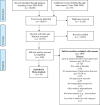Psychological and contextual risk factors for first-onset depression among adolescents and young people around the globe: A systematic review and meta-analysis
- PMID: 35388612
- PMCID: PMC10084304
- DOI: 10.1111/eip.13300
Psychological and contextual risk factors for first-onset depression among adolescents and young people around the globe: A systematic review and meta-analysis
Abstract
Aim: Identifying predictors for future onset of depression is crucial to effectively developing preventive interventions. We conducted a systematic review and meta-analysis to identify risk factors for first-onset depression among adolescents and young people.
Methods: We searched MEDLINE (Ovid), PsycINFO, Cochrane Database, Web of Science, Lilacs, African Journals Online and Global Health (July 2009 to December 2020) for longitudinal studies assessing risk factors for first-onset depression among adolescents and young people aged 10-25 years. Meta-analyses generated summary odds ratio (OR) estimates.
Registration: PROSPERO CRD42018103973.
Results: Nineteen studies representing 21 unique populations were included in the meta-analysis. Among studies reporting race/ethnicity, 79% of participants were of White/European descent. Seventeen studies were from high-income countries, with only two from an upper-middle-income country (China). Odds for first-onset depression were significantly greater for girls compared to boys (n = 13; OR = 1.78 [1.78, 2.28], p < 0.001) and for youth with other mental health problems at baseline (n = 4; OR = 3.20 [1.95, 5.23], p < 0.001). There were non-significant associations for negative family environment (n = 8; OR = 1.60 [0.82, 3.10], p = 0.16) and parental depression (n = 3; OR = 2.30 [0.73, 7.24], p = 0.16).
Conclusions: Most longitudinal studies do not report risk factors specifically for first-onset depression. Moreover, predictive data are limited to predominantly White populations in high-income countries. Future research must be more ethnically and geographically representative. Recommendations are provided for consistent and comprehensive reporting of study designs and analyses of risk factors for first-onset depression.
Keywords: adolescent; developing countries; early diagnosis; risk assessment; risk factors.
© 2022 The Authors. Early Intervention in Psychiatry published by John Wiley & Sons Australia, Ltd.
Conflict of interest statement
VM has received research funding from Johnson & Johnson, a pharmaceutical company interested in the development of anti‐inflammatory strategies for depression, but the research described in this paper is unrelated to this funding. All other authors declare that they have no competing interests.
Figures


Similar articles
-
Psychological and/or educational interventions for the prevention of depression in children and adolescents.Cochrane Database Syst Rev. 2004;(1):CD003380. doi: 10.1002/14651858.CD003380.pub2. Cochrane Database Syst Rev. 2004. Update in: Cochrane Database Syst Rev. 2011 Dec 07;(12):CD003380. doi: 10.1002/14651858.CD003380.pub3. PMID: 14974014 Updated.
-
E-Health interventions for anxiety and depression in children and adolescents with long-term physical conditions.Cochrane Database Syst Rev. 2018 Aug 15;8(8):CD012489. doi: 10.1002/14651858.CD012489.pub2. Cochrane Database Syst Rev. 2018. PMID: 30110718 Free PMC article.
-
Welfare-to-work interventions and their effects on the mental and physical health of lone parents and their children.Cochrane Database Syst Rev. 2018 Feb 26;2(2):CD009820. doi: 10.1002/14651858.CD009820.pub3. Cochrane Database Syst Rev. 2018. PMID: 29480555 Free PMC article.
-
Interventions for promoting habitual exercise in people living with and beyond cancer.Cochrane Database Syst Rev. 2018 Sep 19;9(9):CD010192. doi: 10.1002/14651858.CD010192.pub3. Cochrane Database Syst Rev. 2018. PMID: 30229557 Free PMC article.
-
Antidepressants for depression in adults with HIV infection.Cochrane Database Syst Rev. 2018 Jan 22;1(1):CD008525. doi: 10.1002/14651858.CD008525.pub3. Cochrane Database Syst Rev. 2018. PMID: 29355886 Free PMC article.
Cited by
-
Longitudinal Prediction of Adolescent Depression from Environmental and Polygenic Risk Scores.medRxiv [Preprint]. 2025 Jul 8:2025.07.08.25331098. doi: 10.1101/2025.07.08.25331098. medRxiv. 2025. PMID: 40672501 Free PMC article. Preprint.
-
Family Functioning, Maternal Depression, and Adolescent Cognitive Flexibility and Its Associations with Adolescent Depression: A Cross-Sectional Study.Children (Basel). 2024 Jan 22;11(1):131. doi: 10.3390/children11010131. Children (Basel). 2024. PMID: 38275441 Free PMC article.
-
Fortifying the Foundations: A Comprehensive Approach to Enhancing Mental Health Support in Educational Policies Amidst Crises.Healthcare (Basel). 2023 May 14;11(10):1423. doi: 10.3390/healthcare11101423. Healthcare (Basel). 2023. PMID: 37239709 Free PMC article.
-
Neurocognitive risk phenotyping to predict mood symptoms in adolescence.J Psychopathol Clin Sci. 2024 Jan;133(1):90-102. doi: 10.1037/abn0000866. Epub 2023 Dec 7. J Psychopathol Clin Sci. 2024. PMID: 38059934 Free PMC article.
-
Strengthening self-regulation and reducing poverty to prevent adolescent depression and anxiety: Rationale, approach and methods of the ALIVE interdisciplinary research collaboration in Colombia, Nepal and South Africa.Epidemiol Psychiatr Sci. 2023 Dec 13;32:e69. doi: 10.1017/S2045796023000811. Epidemiol Psychiatr Sci. 2023. PMID: 38088153 Free PMC article.
References
-
- Abela, J. R. Z. , & Hankin, B. L. (2011). Rumination as a vulnerability factor to depression during the transition from early to middle adolescence: A multiwave longitudinal study. Journal of Abnormal Psychology, 120(2), 259–271. - PubMed
-
- Alloy, L. B. , Abramson, L. Y. , Whitehouse, W. G. , Hogan, M. E. , Panzarella, C. , & Rose, D. T. (2006). Prospective incidence of first onsets and recurrences of depression in individuals at high and low cognitive risk for depression. Journal of Abnormal Psychology, 115(1), 145–156. - PubMed
-
- Angst, J. , Dobler‐Mikola, A. , & Binder, J. (1984). The Zurich study ?A prospective epidemiological study of depressive, neurotic and psychosomatic syndromes. European Archives of Psychiatry and Neurological Sciences, 234(1), 13–20. - PubMed
-
- Angst, J. , Gamma, A. , Neuenschwander, M. , Ajdacic‐Gross, V. , Eich, D. , Rössler, W. , & Merikangas, K. R. (2005). Prevalence of mental disorders in the Zurich cohort study: A twenty year prospective study. Epidemiologia e Psichiatria Sociale, 14(2), 68–76. - PubMed
Publication types
MeSH terms
Grants and funding
LinkOut - more resources
Full Text Sources
Medical

